|
 |
| Adult female, San Diego County |
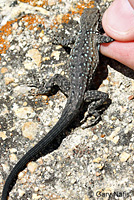 |
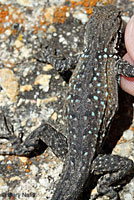 |
 |
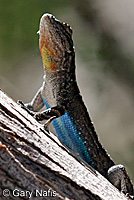 |
| |
Adult male, San Diego County |
|
Adult male, San Diego County |
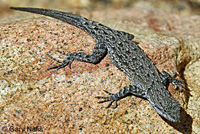 |
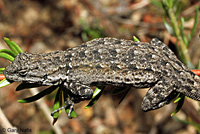 |
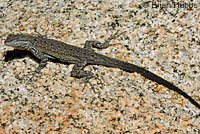 |
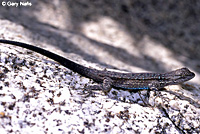 |
| |
Adult female, San Diego County |
Adult, Imperial County © Brian Hubbs |
Adult male, San Diego County |
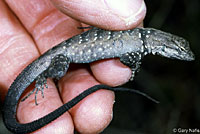 |
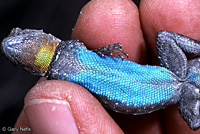 |
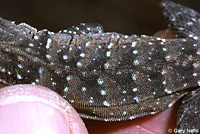 |
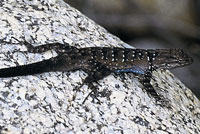 |
| |
Adult male, San Diego County |
|
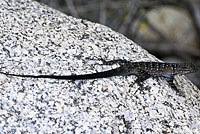 |
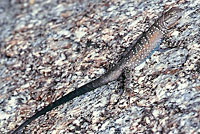 |
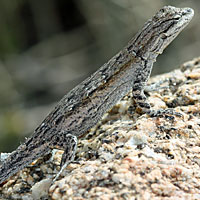 |
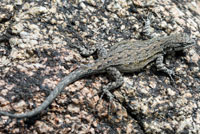 |
| Adult male, San Diego County |
Adult male, San Diego County |
Adult female, San Diego County |
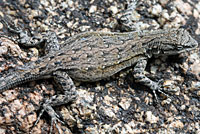 |
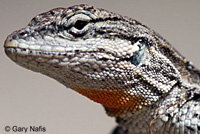 |
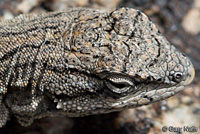 |
 |
| |
Adult female, San Diego County |
|
 |
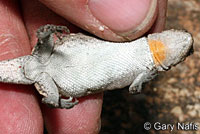 |
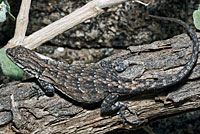 |
 |
| |
Adult female, San Diego County |
|
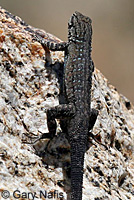 |
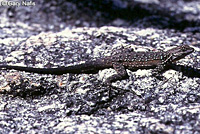 |
 |
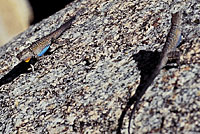 |
| Adult male, San Diego County |
Adult male, San Diego County |
Adult males in combat in San Diego County, showing off their bright throat and ventral colors as a warning to the other male. These lizards were observed running around on top of a large boulder above a palm oasis, chasing and biting each other's tails and paying little attention to the photographer. Bite marks are visible on the tail of the lizard on the left. |
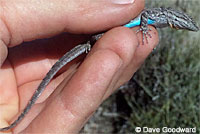 |
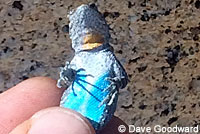 |
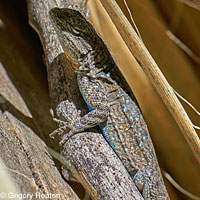 |
 |
| Adult male, San Diego County © Dave Goodward |
Adult male, San Diego County palm oasis © Grigory Heaton |
Undersides of female (left)
and male (right) Small-scaled Lizards from San Diego County.
Both sexes of U. microscutatus have a patch of orange or yellow or both colors on the throat. Males have an almost solid blue belly. © Stuart Young |
| |
|
|
|
| Comparison with Similar Sympatric Species |
There are two other similar species of lizards that are found in California, but only the Western Long-tailed Brush Lizard shares part of its range with the Small-scaled Lizard. The Tree Lizard has spread beyond its range into some areas and could possibly be found in the range of the Small-scaled Lizard so it is included here.
The three species can be separated best by looking at the wide band of enlarged scales on the middle of the back.
|
 |
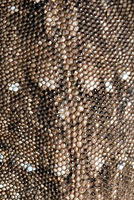 |
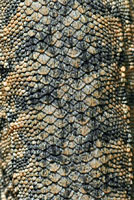 |
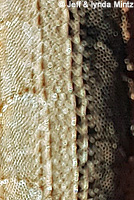 |
Small-scaled Lizard - Urosaurus microscuatus
The Small-scaled Lizard has a mixture of small granular scales and larger weekly-keeled scales on the dorsal surface.
The band of enlarged weekly-keeled scales is not split in the center by a band of smaller scales.
These enlarged scales are smaller than those of the Western Long-tailed Brush Lizard, shown to the right. |
Western Long-tailed Brush Lizard - Urosaurus graciosus
The Western Long-tailed Brush Lizard has a band of slightly-enlarged scales on the middle of the back that are
not split in the center by a band of smaller scales.
These enlarged scales are larger than those of the Small-scaled Lizard, shown to the left.. |
Tree Lizard - Urosaurus ornatus
This tree lizard appears to be the Colorado River Tree Lizard - U. o. symmetricus, the subspecies found in California. It was found in Barstow, outside of the known range of this subspecies, but the scales on the back show wide scales on the back that are split in the center by a large band of smaller scales that is typical of this subspecies.
Another example can be seen here: H.E.R.P. Database |
 |
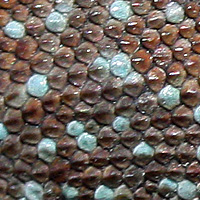 |
 |
|
Spiny Lizards
Western Fence Lizards and Sagebrush lizards have large overlapping scales with spines on the back. |
Western Side-blotched Lizard - Uta stansburiana ellegans
The Western Side-blotched Lizard has small scales on the back with no band of enlarged scales in the middle, and typically has a large dark blotch on the sides behind the front legs.
|
|
 |
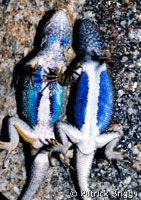 |
|
|
| Underside of adult male Small-scaled Lizard. |
Western Fence Lizard on the left, Common Sagebrush Lizard on the right.
Males of both species have blue, not yellow or orange on the throat and split bands of bright blue color on the belly. The fence lizard also has yellow on the backs of the thighs.
© Patrick Briggs |
|
|
| |
|
|
|
| Habitat |
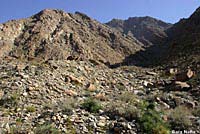 |
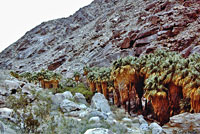 |
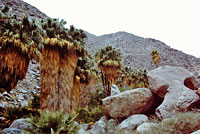 |
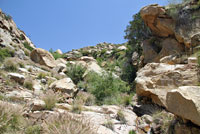 |
Habitat San Diego County
|
Habitat, palm oasis, San Diego County
|
Habitat, San Diego County
|
 |
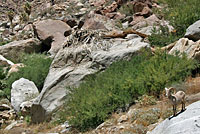 |
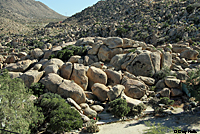 |
|
Habitat San Diego County
|
Habitat with Bighorn ram,
San Diego County
|
Habitat Imperial County
|
|
| |
| Short Videos |
 |
 |
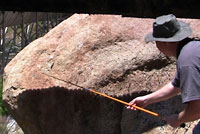 |
|
| Some good looks at a camera-tolerant female Small-scaled Lizard before she bolts, with some impressive tail wagging. |
A female Small-scaled Lizard does a few push-up displays and some tail wagging. |
This video shows how to noose a lizard. Notice the lizard's defensive push-up behavior towards the noose. After a missed attempt, Stuart finally gets the noose around the lizard's neck and pulls him off the rock, being careful not to injure him. It's a colorful male Small-scaled Lizard. After we admire him, he is put back on his boulder. |
|
|
|
|
|
| Description |
| |
| Size |
1.5 - 2 inches long from snout to vent (3.8 - 5.1 cm). (Stebbins 2003)
|
| Appearance |
A small, lizard with a long, thin tail.
Scales are small and granular with a band of enlarged keeled scales down the middle of the back.
Scales on the tail are keeled.
Gular fold across the throat, and folds along the sides of the body.
The tail detaches easily and regenerates.
|
| Color and Pattern |
Color is gray, brown, or sooty, with dark blotches or crossbars on the back, sometimes edged with light coloring or white spots.
The tail is usually black, especially on males.
The dark color is more noticeable when a lizard's body is in the light phase.
(Lizards west of the mountains often do not have a black tail. [Lemm 2006])
Sometimes there is an irregular gray or brown stripe down the middle of the back.
The tail, upper sides, and neck are sometimes marked with rust or yellow-brown coloring.
The underside is light yellow-gray or white, sometimes with darker coloring under the tail. |
| Male / Female Differences |
Males have yellow or orange in the middle of the throat, which can be blue, and blue to blue-green patches on the belly, which may connect in the center, and enlarged post-anal scales.
Females have a yellow, orange, or white throat, with no blue on the belly.
|
| Life History and Behavior |
Activity |
A good climber.
Moves quickly from rock to rock.
Active spring and summer and sometimes in fall, hibernating in winter with groups of other lizards.
|
| Territoriality |
Males defend their territory and try to attract females with head-bobbing and a push-up display that exposes their throat and ventral colors.
Females also do a push-up display . |
| Defense |
The dark tail may serve to distract a predator to an expendable body part.
The tail can break off easily, but it will grow back.
The detached tail wriggles on the ground which can distract a predator from the body of the lizard allowing it time to escape.
More information about tail loss and regeneration. |
| Diet and Feeding |
| Eats small invertebrates. |
| Reproduction |
Breeds April through summer.
1 - 2 clutches of 4 - 8 eggs are laid June to August and possibly as late as September.
|
| Habitat |
Inhabits rocky places with sufficient plants and trees for cover in desert and semi-arid areas. Especially fond of riparian areas.Sometimes found on buildings and other human constructions.
|
| Geographical Range |
Inhabits both sides of the Peninsular ranges in San Diego County south to Baja California del Sur.
In California, found from Borrego Palm Canyon on the desert side of the Peninsular Mountains, to Marron Valley, Cottonwood, and Deerhorn Flat areas on the coastal side. (Stebbins 2003)
|
 |
| Elevational Range |
From sea level to around 7,000 ft. (2,100 m) but usually below 5,000 ft. in San Diego County. (Lemm 2006)
|
| Notes on Taxonomy |
The small-scaled lizard, Urosaurus microscutatus, was formerly considered a different species from Urosaurus nigricaudus. U. microscutatus has since been identified as the same species, and a synonym of U. nigricaudus.
Some sources continue to refer to this species as Urosaurus nigricaudus - Black-tailed Brush Lizard.
2017 Name Change
SSAR Herpetological Circular No. 43, 2017 changed the name of this species on their list from
Urosaurus nigricaudus - Baja Caifornia Brush Lizard to
Urosaurus microscutatus - Small-scaled Lizard,
with the following notes:
"Based on genome-wide SNP data, Gottscho (2015, Ph.D. dissertation, Univ. California, Riverside and San Diego State Univ.) found that U. nigricaudus and U. microscutatus (considered conspecific with U. nigricaudus by Aguirre et al. (1999, Herpetologica 55: 369–381)) are reciprocally monophyletic and exhibit limited evidence of admixture, with an estimated divergence time in the Late Miocene to Early Pliocene. We have therefore treated them as separate species."
---------------------------------------------------------------------------------------------------------------------------------------------------------------------------------------------------------------------------
2008 Name Change
The 2008 SSAR Herpetological Circular changed the name of this lizard from
Urosaurus microscutatus - Small-scaled Lizard to
Urosaurus nigricaudus - Baja Caifornia Brush Lizard,
with the following notes:
"Aguirre et al. (1999, Herpetologica 55: 369–381) and Grismer (1999, Herpetologica 55: 446–469) presented evidence that Urosaurus microscutatus and U. nigricaudus
constitute a single species, for which the name U. nigricaudus has priority and within which no subspecies were recognized. The English name Black-tailed Brush Lizard was applied to U. nigricaudus when that species was thought to include only populations from southern Baja California; however, that name is descriptively misleading when applied to the species as currently circumscribed. Although the English name Baja California Brush Lizard has been used for U. lahtelai (e.g., Stebbins, 1985, A Field Guide to Western Reptiles and Amphibians, Houghton Mifflin Co.; Grismer, 2002, Amphibians and Reptiles of Baja California, Including Its Pacific Islands and the Islands in the Sea of Cortés, Univ. California Press), that species is restricted to a small area in the vicinity of Cataviña (suggesting the English name Cataviña Brush Lizard); in contrast, U. nigricaudus is widely distributed in, and more-or-less restricted to, Baja California.
Alternate and Previous Names (Synonyms)
Urosaurus nigricaudus - Black-tailed Brush Lizard (Stebbins 2003, Stebbins & McGinnis 2012)
Urosaurus microscutatus - Small-scaled Lizard (Stebbins 1966, 1985)
Uta microscutata - Small-scaled Lizard (Stebbins 1954
Urosaurus microscutatus - Small-scaled Uta (Smith 1946)
|
| Conservation Issues (Conservation Status) |
| None |
|
|
Taxonomy |
| Family |
Phrynosomatidae |
Zebra-tailed, Earless, Fringe-toed, Spiny, Tree, Side-blotched, and Horned Lizards |
Fitzinger, 1843 |
| Genus |
Urosaurus |
Tree and Brush Lizards |
Hallowell, 1854 |
Species
|
microscutatus |
Small-scaled Lizard |
(Van Denburgh, 1894) |
|
Original Description |
Urosaurus - Hallowell, 1854 - Proc. Acad. Nat. Sci. Philadelphia, Vol. 7, p. 92
Urosaurus nigricaudus - (Van Denburgh, 1894)
from Original Description Citations for the Reptiles and Amphibians of North America © Ellin Beltz
|
|
Meaning of the Scientific Name |
Urosaurus - Greek - oura = tail + saurus = lizard
microscutatus - Latin - micro = small + scutatus = scaled - refers to the lack of enlarged dorsal scales as found in other members of the genus
from Scientific and Common Names of the Reptiles and Amphibians of North America - Explained © Ellin Beltz
|
|
Related or Similar California Lizards |
U. graciosus - Long-tailed Brush Lizard
U. o. symmetricus - Colorado River Tree Lizard
Uta stansburiana - Side-blotched Lizard
|
|
More Information and References |
California Department of Fish and Wildlife
Hansen, Robert W. and Shedd, Jackson D. California Amphibians and Reptiles. (Princeton Field Guides.) Princeton University Press, 2025.
Stebbins, Robert C., and McGinnis, Samuel M. Field Guide to Amphibians and Reptiles of California: Revised Edition (California Natural History Guides) University of California Press, 2012.
Stebbins, Robert C. California Amphibians and Reptiles. The University of California Press, 1972.
Flaxington, William C. Amphibians and Reptiles of California: Field Observations, Distribution, and Natural History. Fieldnotes Press, Anaheim, California, 2021.
Nicholson, K. E. (ed.). 2025. Scientific and Standard English Names of Amphibians and Reptiles of North America North of Mexico, with Comments Regarding Confidence in Our Understanding. Ninth Edition. Society for the Study of Amphibians and Reptiles. [SSAR] 87pp.
Samuel M. McGinnis and Robert C. Stebbins. Peterson Field Guide to Western Reptiles & Amphibians. 4th Edition. Houghton Mifflin Harcourt Publishing Company, 2018.
Stebbins, Robert C. A Field Guide to Western Reptiles and Amphibians. 3rd Edition. Houghton Mifflin Company, 2003.
Behler, John L., and F. Wayne King. The Audubon Society Field Guide to North American Reptiles and Amphibians. Alfred A. Knopf, 1992.
Robert Powell, Roger Conant, and Joseph T. Collins. Peterson Field Guide to Reptiles and Amphibians of Eastern and Central North America. Fourth Edition. Houghton Mifflin Harcourt, 2016.
Powell, Robert., Joseph T. Collins, and Errol D. Hooper Jr. A Key to Amphibians and Reptiles of the Continental United States and Canada. The University Press of Kansas, 1998.
Bartlett, R. D. & Patricia P. Bartlett. Guide and Reference to the Turtles and Lizards of Western North America (North of Mexico) and Hawaii. University Press of Florida, 2009.
Jones, Lawrence, Rob Lovich, editors. Lizards of the American Southwest: A Photographic Field Guide. Rio Nuevo Publishers, 2009.
Smith, Hobart M. Handbook of Lizards, Lizards of the United States and of Canada. Cornell University Press, 1946.
Grismer, L. Lee. Amphibians and Reptiles of Baja California, Including Its Pacific Islands and the Islands in the Sea of Cortés. The University of California Press, 2002.
McPeak, Ron H. Amphibians and Reptiles of Baja California. Sea Challengers, 2000.
Samuel M. McGinnis and Robert C. Stebbins. Peterson Field Guide to Western Reptiles & Amphibians. 4th Edition. Houghton Mifflin Harcourt Publishing Company, 2018.
Stebbins, Robert C. A Field Guide to Western Reptiles and Amphibians. 3rd Edition. Houghton Mifflin Company, 2003.
The Reptile Database
Lemm, Jeffrey. Field Guide to Amphibians and Reptiles of the San Diego Region (California Natural History Guides). University of California Press, 2006.
|
|
|
The following conservation status listings for this animal are taken from the April 2024 State of California Special Animals List and the April 2024 Federally Listed Endangered and Threatened Animals of California list (unless indicated otherwise below.) Both lists are produced by multiple agencies every year, and sometimes more than once per year, so the conservation status listing information found below might not be from the most recent lists. To make sure you are seeing the most recent listings, go to this California Department of Fish and Wildlife web page where you can search for and download both lists:
https://www.wildlife.ca.gov/Data/CNDDB/Plants-and-Animals.
A detailed explanation of the meaning of the status listing symbols can be found at the beginning of the two lists. For quick reference, I have included them on my Special Status Information page.
If no status is listed here, the animal is not included on either list. This most likely indicates that there are no serious conservation concerns for the animal. To find out more about an animal's status you can also go to the NatureServe and IUCN websites to check their rankings.
Check the current California Department of Fish and Wildlife sport fishing regulations to find out if this animal can be legally pursued and handled or collected with possession of a current fishing license. You can also look at the summary of the sport fishing regulations as they apply only to reptiles and amphibians that has been made for this website.
This animal is not included on the Special Animals List, which indicates that there are no significant conservation concerns for it in California.
|
| Organization |
Status Listing |
Notes |
| NatureServe Global Ranking |
|
|
| NatureServe State Ranking |
|
|
| U.S. Endangered Species Act (ESA) |
None |
|
| California Endangered Species Act (CESA) |
None |
|
| California Department of Fish and Wildlife |
None |
|
| Bureau of Land Management |
None |
|
| USDA Forest Service |
None |
|
| IUCN |
|
|
|
|























































